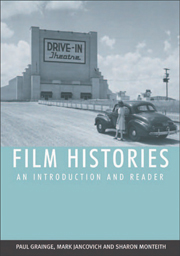Book contents
- Frontmatter
- Contents
- Preface
- Part I Film History from its Origins to 1945
- 1 The Emergence of Cinema
- 2 Organising Early Film Audiences
- 3 Nationalism, Trade and Market Domination
- 4 Establishing Classical Norms
- 5 The Age of the Dream Palace and the Rise of the Star System
- 6 Competing with Hollywood: National Film Industries outside Hollywood
- 7 The Rise of the Studios and the Coming of Sound
- 8 Realism, Nationalism and ‘Film Culture’
- 9 Adjustment, Depression and Regulation
- 10 Totalitarianism, Dictatorship and Propaganda
- 11 The Common People, Historical Drama and Preparations for War
- 12 Wartime, Unity and Alienation
- Part II Film History from 1946 to the Present
- Bibliography
- Copyright Acknowledgements
- Index
4 - Establishing Classical Norms
from Part I - Film History from its Origins to 1945
Published online by Cambridge University Press: 05 August 2013
- Frontmatter
- Contents
- Preface
- Part I Film History from its Origins to 1945
- 1 The Emergence of Cinema
- 2 Organising Early Film Audiences
- 3 Nationalism, Trade and Market Domination
- 4 Establishing Classical Norms
- 5 The Age of the Dream Palace and the Rise of the Star System
- 6 Competing with Hollywood: National Film Industries outside Hollywood
- 7 The Rise of the Studios and the Coming of Sound
- 8 Realism, Nationalism and ‘Film Culture’
- 9 Adjustment, Depression and Regulation
- 10 Totalitarianism, Dictatorship and Propaganda
- 11 The Common People, Historical Drama and Preparations for War
- 12 Wartime, Unity and Alienation
- Part II Film History from 1946 to the Present
- Bibliography
- Copyright Acknowledgements
- Index
Summary
The formation of the major Hollywood studios developed from market struggles between the Motion Picture Patents Company (MPPC) and a group of independents spearheaded by Carl Laemmle. Running the largest American distribution firm, Laemmle was unwilling to pay licence fees to the MPPC. This meant he was restricted from purchasing films to supply his customers, unable to buy titles from Biograph, Vitagraph, Edison, Pathé, or any of the other major affiliated companies. As a result, Laemmle began his own firm, founding the Independent Moving Picture Company (or IMP as it became known) in 1909. This company produced its own films, releasing two reels a week together with reels supplied by Italian companies such as Ambrosio and Itala. This marked a surge of activity in the independent sector, unlicensed producers, distributors and exhibitors allying themselves in ways that would unravel the power of the MPPC.
Together with IMP, a number of independent producers emerged in 1910. This included the Centaur Film Manufacturing Company, the Nestor Company, the Thanhouser Company, and the New York Motion Picture Company. In the same year, the independent producers established a co-operative distribution arm called the Motion Picture Distribution and Sales Company. This would help organise the independent field by regulating release dates and film prices and mirrored the function of the General Film Company, established by the Trust in 1910. Both were attempts to monopolise distribution in the domestic market and set in place a power struggle to control the US film industry.
- Type
- Chapter
- Information
- Film HistoriesAn Introduction and Reader, pp. 67 - 92Publisher: Edinburgh University PressPrint publication year: 2007



